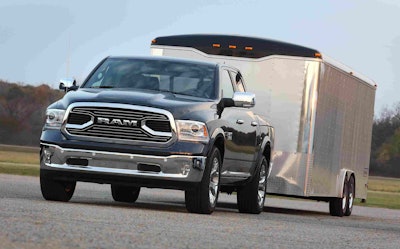 The Diesel Technology Forum is excited about new clean diesel technology in light-duty applications. In its latest report, DTF refers to the Ram 1500 with a 3.0-liter turbo EcoDiesel, which has the highest rated fuel economy of any OEM 1/2-ton pickup at 29 mpg highway.
The Diesel Technology Forum is excited about new clean diesel technology in light-duty applications. In its latest report, DTF refers to the Ram 1500 with a 3.0-liter turbo EcoDiesel, which has the highest rated fuel economy of any OEM 1/2-ton pickup at 29 mpg highway.Advancements in emissions control technology in clean diesel passenger cars and light duty pickup trucks will have a positive effect on efforts to reduce future greenhouse gas emissions, according to the federal government’s newly-released Draft Technical Assessment Report (TAR).
On Monday, the U.S. Department of Transportation (DOT), the U.S. Environmental Protection Agency (EPA), and the California Air Resource Board (CARB) released the mid-term evaluation of the National Program for greenhouse gas emissions and fuel economy standards for light duty cars and trucks.
The Draft TAR, which covers vehicle model years 2022-2025, confirms that automotive manufacturers are introducing new technology to market at a rapid pace, and predicts that model year 2022-2025 standards are achievable with a wide range of technologies.
“Despite recent EPA and California ARB compliance actions with respect to light-duty diesel NOx emissions, diesel engines remain a technology for the reduction of GHG emissions from light-duty vehicles,” reports the Draft TAR.
“Advances in NOx and PM emissions control technology are bringing light duty diesels fully into compliance with Federal Tier 3 and California LEV III emissions standards at a cost that is competitive with the cost-effectiveness of other high efficiency, advanced engine technologies.”
The government’s assessment is good news for the Diesel Technology Forum (DTF).
“We’re extremely pleased that EPA, DOT and CARB recognize at this time especially the Greenhouse Gas emissions improvements in new and future clean diesel technology and fuels,” said Allen Schaeffer, DTF executive director.
“Automakers and engine manufacturers have invested billions of dollars in diesel research and development to significantly improve the fuel efficiency and emissions from modern diesel vehicles.
While the Draft TAR specifically highlights advanced gasoline vehicles as being the primary source for achieving future fuel efficiency levels, DTF believes that new clean diesel engines will also play a key role in reaching the 2025 mileage goals.
“Achieving the increased fuel economy standards is going to be difficult. This is a tremendous challenge for the industry,” Schaeffer said.
“However, today clean diesel cars average about 30 percent better fuel economy than their gasoline counterparts. In the light duty truck sector, new clean diesel pickups are achieving higher mpg levels and for the first time a diesel pickup truck has reached the 30 mpg highway level.”
Schaeffer is referring to the Ram 1500 with a 3.0-liter turbo EcoDiesel, which is rated at 29 mpg highway.
As additional high-mileage clean diesel cars and pickup trucks are introduced in the U.S., DTF anticipates growth in the diesel market along with diesel’s role in helping achieve future fuel efficiency standards.
The Draft TAR states that diesel engines are continuing to evolve using technologies similar to those being introduced in new light-duty gasoline engines and heavy-duty diesel truck engines, including the use of:
– Advanced friction reduction measures
– Increased turbocharger boosting and engine downsizing
– Engine “down-speeding”
– The use of advanced cooled EGR systems
– The improved integration of charge air cooling into the air intake system
– And the improved integration of exhaust emissions control systems for criteria pollutant control
According to the Draft TAR, the best Brake Thermal Efficiency (BTE)—a measure of energy efficiency—of advanced diesel engines under development for light duty applications is now 46 percent and thus is approaching that of heavy-duty diesel truck engines. In contrast, gasoline engines today achieve around 37 percent.
The draft report also summarizes the results of commissioned research surveying auto reviews of advanced fuel economy technologies. Three-out-of-four auto writers and auto analysts report a favorable rating for diesel technology concerning consumer acceptance, which was among the highest rated powertrains.








